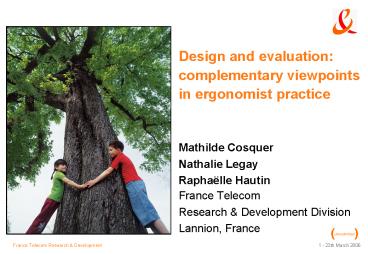Mathilde Cosquer - PowerPoint PPT Presentation
Title:
Mathilde Cosquer
Description:
Essential to take part both in design and evaluation ... methods (Falzon et al., 2004; Valentin et al., 1993; Senach, 1993; Bastien ... – PowerPoint PPT presentation
Number of Views:49
Avg rating:3.0/5.0
Title: Mathilde Cosquer
1
Design and evaluation complementary viewpoints
in ergonomist practice
- Mathilde Cosquer
- Nathalie Legay
- Raphaëlle Hautin France Telecom
- Research Development Division
- Lannion, France
2
Introduction
- Our ergonomists experience
- Essential to take part both in design and
evaluation - To build new telecom products and services to
user needs - Evaluation
- Reference situations from users feedback support
for future designs - Design
- Evaluation results relativized and integrated
more efficiently in the project
3
Outline of presentation
- Brief reminder of principles of user-centered
design - Real examples from our ergonomic practice in the
field of telecommunications - Discussion to increase the value of combined
design and evaluation activities - Conclusion
4
Brief reminder of principles of user-centered
design
- Activity of the ergonomist
- To globally ensure the utility and usability of
products and services available to users (e.g.
ISO 9241-11, 1998) - Fields of knowledge
- Psychology, physiology, ergonomic standards,
style guidelines, etc - Various processes and methods used to collect
data on users, tasks and contexts of use - Human focused design processes for interactive
systems (e.g.ISO 13407, 1999) - Usability methods supporting human focused design
(e.g.ISO/TR 16982, 2001) - Evaluation methods (Falzon et al., 2004 Valentin
et al., 1993 Senach, 1993 Bastien and Scapin,
1993) user tests, interviews, questionnaires,
expert assessments
5
Real examples from our ergonomic practice in the
field of telecommunications (mass-market)
- Focus on two types of intervention
- Contribution to interface specifications U Design
- Performance of user tests U Evaluation
- Design activity
- Project constraints from marketing and technical
areas - Ergonomic requirements based on
- Standards, style guidelines, lookfeel charts
- Results of user tests
- Design examples
- MMI specification on Web interface for virtual
office (PC and PDA) - Tree structure and navigation in interactive
voice services (voice recognition) - Graphical interface specifications on small
screens for TV on mobile
6
Real examples from our ergonomic practice in the
field of telecommunications (mass-market)
- Evaluation activity user tests
- In laboratory 12 users test mock-ups/prototypes/p
roducts on basis of scenarios completing the use
of the service - Objectives
- Usability testing by highlighting strengths and
weaknesses - Recommendations to improve products or services
- User tests examples
- Web service allowing management of
telecommunication services perimeter users
understood, main actions and terminology testing - Comparative on handsets physical and graphical
interfaces
7
Discussion to increase the value of the combined
design and evaluation activities
- From evaluating ergonomist's viewpoint benefits
of design - Design activity may be compared to problem
solving data and constraints at the beginning
and solution has to be found - Better understanding of the state of the device
which is to be tested - Better understanding of design team's needs
- Better understanding of the team's "state of
mind" - Better knowledge of the way recommendations may
be integrated into design
8
Discussion to increase the value of the combined
design and evaluation activities
- From design ergonomist's viewpoint benefits of
evaluation (1/2) - Carrying out user tests involves confronting
variability of users, tasks to be completed and
contexts of use - Reality for users more complex and varied than
representation imagined in laboratory - Contact with "real users" to paint the most
realistic representation of them - In the definition phase of design solutions, the
ergonomist will be able to tap into his own
experience - Exploit knowledge of activity
9
Discussion to increase the value of the combined
design and evaluation activities
- From design ergonomist's viewpoint benefits of
evaluation (2/2) - Hypothesis in design solutions that must be
tested by users - Maintain habit of defining usability criteria
(effectiveness, efficiency, satisfaction) - Use "user test" tool better in a better way, such
as - Tackling the work design via evaluation
- Re-orienting marketing target, convincing other
project protagonists
10
Conclusion
- Our ergonomists' experience has taught us that
- These various interventions (user-test and
design) are complementary and indispensable when
gaining concrete experience for the benefit of
users and the telecommunications
products/services they use - User-test is not enough
- Vary approaches in order to be a little closer to
the variety of users and activities - Others methods needed analysis in situ, tools to
trace the real activity of users, multi-expert
meetings, user round table, qualitative analysis
of uses
11
Conclusion
- Makes it easier to convince that ergonomics
intervenes via a global approach during the
project live - Boundaries between "design" ergonomist and
"evaluator" ergonomist should be less distinct - Thank you !































